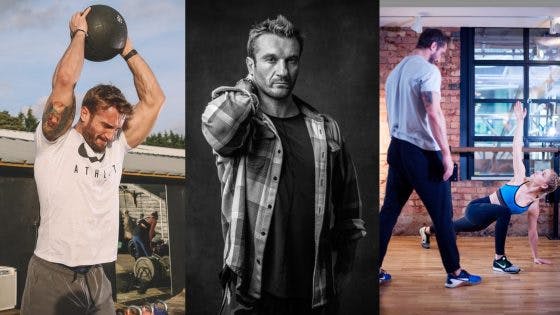Here’s Why You Should Try Strength Training, According To A Top Celebrity Trainer
6 minutes read
You’ll be surprised to know that most of the female celebrities you follow do strength training as part of their exercise regimen.

The UK’s top personal trainer, Luke Worthington, who trains a roster of high-profile names in film, fashion and sports, can attest to that: “All of my [female] clients strength train regularly. Some of my higher profile female clients are Rooney Mara, Dakota Johnson, Ellie Bamber, Munroe Bergdorf, Jodie Comer, and Winnie Harlow.”
If you need more convincing on whether or not to engage in strength training, you’re in for a treat as Worthington explains why strength training is one of the best activities you can do for your health, anywhere from the comfort of your home.
What is strength training?
Strength training – also called resistance training or weight training – is a type of exercise that requires repetitive contraction of the major muscle groups against an opposing force, typically a free weight or with the aid of gym equipment.
Some examples of strength training include lifting weights, using resistance bands leveraging your body weight for resistance, push-ups, squats, and weight machines at a gym.
Why is strength training important for women?
As a qualified sports scientist, strength and conditioning specialist with over 20 years’ of experience, Worthington’s philosophy on health and fitness addresses all five pillars of well-being: strength, cardiovascular fitness, mobility, body composition, and emotional well-being.
“Strength training is really the ‘cup’ that all of the others sit within – as it is the one modality that has a positive effect on all of the others,” he explains.
Strength training makes you stronger, leaner and healthier. Indeed, experts say strength training enhances your quality of life and improves your ability to do everyday activities.
What are the benefits of strength training?
“Aside from the aesthetic and functional benefits of becoming stronger, strength training has been shown to improve bone density, hormonal health, self-confidence as well as reduce the risk of injury,” explains Worthington.
Manage your weight
If you are keen to manage or shed unwanted weight, strength training can be of help. It’s great for women vying to maintain a healthy weight without counting calories as it can boost your metabolism and help you burn more energy as a result.
Read next: 7 Expert-Backed Ways to Boost Your Metabolism
Boost your thinking skills
Regular strength training can help protect the brain from degeneration. Research shows that regular strength training and aerobic exercise may improve thinking and learning skills in older adults.
A separate clinical study conducted by The University of Sydney found that strength training led to overall benefits in cognitive performance, and benefits linked to preventing degeneration in specific subregions of the hippocampus (the part of the brain with a major role in learning and memory.)
Ward off chronic conditions
It has been long proven that physical activity prevents chronic diseases, and incorporating strength training into your routine can reduce the signs and symptoms of many chronic conditions, such as arthritis, back pain, obesity, heart disease, depression and diabetes.
Misconceptions about strength training
If the idea of weights puts you off, Worthington says: “Strength training doesn’t have to mean weights.”
“Although that is definitely the most effective way to build strength, so long as we are applying the principle of progressive overload (in other words more work is done over time). We can build strength with resistance bands, bodyweight, sandbags, swimming, gymnastics and even some forms of yoga,” says Worthington.
Another major misconception Worthington wants to debunk is the myth that women training with weights will accidentally become ‘bulky.’
“This simply isn’t true and is actually a physiological impossibility,” he says. “If we train specifically for hypertrophy (muscle growth), and create the ideal nutritional and hormonal environment for this – then the maximum rate of muscle growth we can realistically hope to achieve is 1% of body weight per month.
“What is often mistaken for muscle growth is a short-term increase in fluids within the worked muscle – together with a feeling of stiffness. Both of these diminish over 24-48 hours and are simply parts of the recovery process from your workout – not muscle growth,” he adds.
How often should one engage in strength training?
Research shows that frequency rather than intensity is the most efficient way to build progress when we are either new to exercise or returning to it after some time off.
“Frequency is best achieved through following a full-body training plan, rather than a ‘split’ routine (those that focus on one body part or muscle group per workout),” Worthington says.
“The reason for that is that a full body training plan allows for every part of the body (and all muscle groups) to be put through their paces multiple times a week, while a split routine sees them worked more intensely once every seven days.”

7 day strength training routine you can do at home
Worthington shares a seven-day strength training routine you can do at home to start building your strength and endurance.
- Monday: Workout 1 (See below)
- Tuesday: Low-intensity cardio
- Wednesday: Workout 2 (See below)
- Thursday: Low-intensity cardio
- Friday: Workout 1
- Saturday: Higher intensity aerobic training
- Sunday: Rest
“How we put exercises together is key. A technique I to employ with clients when we’re looking for quick results is to pair upper and lower body exercises together in supersets,” Worthington explains.
“Superset essentially means if you perform one set of an upper body exercise, then immediately perform a set of a lower body exercise, then rest, and then repeat the mini circuit for the desired number of sets.
“Since working our muscles requires both oxygen and nutrients to be supplied via the bloodstream,” he explains. “If we group upper and lower body movements into supersets we can use this to our advantage thanks to a phenomenon called ‘venous shunt’.
“This means that the cardiovascular system must quickly move blood from the upper to the lower body as you move through the two exercises, effectively training the cardiovascular system at the same time as the muscular system. Cue greater energy burn, better strength and muscle tone, and improved cardio fitness all in one go,” he concludes.
Some examples of supersets:
Workout 1
- Superset A part I: Back squat
- Superset A part II: Dumbbell row
- Superset B part I: Romanian deadlift
- Superset B part II: Shoulder press (overhead press)
- Superset C part I: Step up
- Superset C part II: Deadbugs
Workout 2
- Superset A part I: Goblet Squat
- Superset A part II: Bodyweight row (TRX row)
- Superset B part I: Hip thrust
- Superset B part II: Push up
- Superset C part I: Split squat
- Superset C part II: Side plank
Random training produces random results. Following a structured, balanced, and progressive program is the most effective and efficient way to gain results from your health and fitness plan. So, we hope this intro to strength training will give you a great starting point into your fitness journey.
If you’re up to it, check Worthington’s The Dumbbell Program (£29.99, 199 pages e-book). It is a 16-week, four-stage progressive program that you can follow either in the gym or at home – all you need is a pair of dumbbells, a towel, a chair, and the self-discipline to follow a plan. It’s suitable for men, and women.
Read next: Functional Movement Exercises To Prevent Seizing Up
Sign up for our newsletter
We will keep you in the loop for special offers, exclusive gifts and product news.

